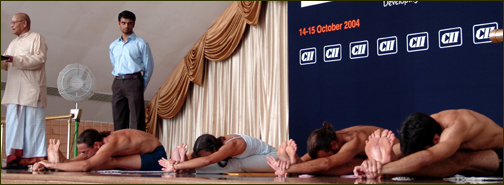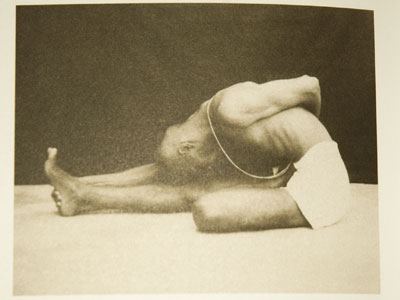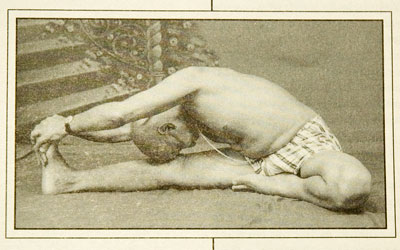alan little’s weblog
notes on nancy, part three
15th November 2004 permanent link
Yogablogging: various notes about, and/or random thoughts inspired by, the yoga course I did last month with Nancy Gilgoff. Part Two.
Some of this stuff enters into the realms of yoga controversy, so I want to be clear where I’m paraphrasing (my recollection of) what Nancy said, and where I’m expressing my own opinions. [I will put bits where I’m editorialising, that may not reflect anything Nancy said or believes, in square brackets]
Nancy says there are a lot of people hurting themselves in yoga these days – lower back, neck, knee and hamstring injuries – and there weren’t twenty years ago.
She attributes this to the creeping influence of Iyengar yoga notions of “correct” posture and alignment in a different form of yoga practice where they don’t belong.

Some advanced yoga practitioners demonstrate forward bends with impressively straight backs.


Some even more advanced yoga practitioners demonstrate impressive indifference to whether their back are straight or not in forward bends: Pattabhi Jois, photographed about fifty years ago, and his teacher Krishnamacharya – arguably the most influential yoga teacher of the last century. (Apologies for the lousy quality of these pictures, which I got by photographing pages in books)
This contrasts with the approach normally taught by Iyengar yoga teachers who emphasise folding from the hips and keeping the back as straight as possible. Here’s one of the things I respect very highly about Nancy. She explains what she believes and why she believes it, but then she also talks with obviously sincere respect about people who have quite different opinions. She mentions another senior and highly respected asthanga teacher (Graeme Northfield I think) who insists on the straight back approach because, she says, it’s what worked for him. Which is why she doesn’t believe in preconceptions about “correct” posture and alignment: “I can’t imagine there’s any one position that’s right for everybody”, and, “if what you’re doing [e.g. straight back] is causing you pain, then do the opposite [e.g. round back]”. [I’m quite sure this is true. Problem: most yoga students don’t have the confidence or experience to know if the position they are trying to get into is right for them. Bigger problem: many yoga teachers probably don’t either]
Note that Nancy absolutely isn’t against Iyengar yoga as a form of practice in it’s own right and speaks with very high respect about Iyengar teachers she has studied with – it’s the mishmash of styles and confused mixing of ideas about how to do things that she’s against.
[My thoughts on this for what they’re worth (note that Nancy has been practicing four times as long as I have and has seen a lot more than four times as many yoga students): I don’t doubt that what Nancy says she sees is true. But here are also an awful lot more people practicing yoga at some level now than there were twenty years ago, and more people hurting themselves is probably inevitable when that happens. Twenty years ago, only a few dedicated people were practicing ashtanga yoga. Now, lots of people are doing it and many of them are doing it on a casual, a couple of classes a week basis which is far more dangerous than dedicated daily practice – more thoughts on this to follow. The average level of teachers’ experience is lower too. I mean no disrespect to the many dedicated and well-intentioned people who are teaching ashtanga yoga these days. But twenty years ago, the only people teaching it were Pattabhi Jois, a couple of other very experienced Indian teachers, and a handful of Pattabhi Jois’s most senior western students who had all spent a lot of time studying with Pattabhi Jois in small groups with very hands-on teaching. Even in Mysore, the teaching just isn’t like that any more – there are many more students, and Pattabhi Jois is older. Less experienced teachers, (again, no matter how dedicated and well-intentioned nearly all of them undoubtedly are) inevitably means more mistakes in teaching, and more injured students.]
More thoughts on the subject of “alignment” and whether it matters from a yoga message board posting I read a couple of years ago (quoted at length because yahoo, these days, requires you to be registered to even read message boards)
… to suggest that “alignment” is of utmost importance and lack of this “alignment” is dangerous, is in itself an uninformed statement. All this hang up on starting a pose with a particular perception of “alignment” is from the BKS Iyengar newfangled method. This eye towards “alignment” is also increased by an attachment and false application of classical form (a western art, dance contrivance) laid onto the yoga system. “Alignment” in an asana develops over time with daily practice. It arises out of proper breath and gaze with mula and uddiyana bandhas. If the student or teacher is looking to create a renaissance inspired form of beauty in order to experience or begin the pose, then he or she is not practicing yoga but posing (ooh pretty).
Many long time ashtanga practitioners develop a graceful quality and line in their practice …. Many long time practitioners do not develop this quality yet have extraodinary, advanced practices with deep insight and experience of the practice as well as of yoga’s many facets. Should we judge a practice by this usually false graceful packaging? No way. Because geting hung up on “alignment” and slow, balletic movements are the biggest pitfalls and side tracks of an ashtanga practice. Focus on this crap and you'll never know what ashtanga practice is.
I am not engaging in some kind of ashtanga-versus-Iyengar sectarian Yoga War here. I have nothing against Iyengar yoga as such(*) – except where its ideas about how to do things intrude where they don’t belong, or when some of its practitioners falsely claim that theirs is the only safe and “correct” way to do things. I don’t like ashtangis who do that either.
(*) In fact, I have so little against Iyengar yoga that, this winter when my ashtanga teacher is in Mysore, I plan to go to classes with a friend of mine who teaches it. Not with any intention of switching, just to see what I might be able to learn from a slightly different yoga perspective.
Notes from the previous course I did with Nancy.
related entries: Yoga
all text and images © 2003–2008